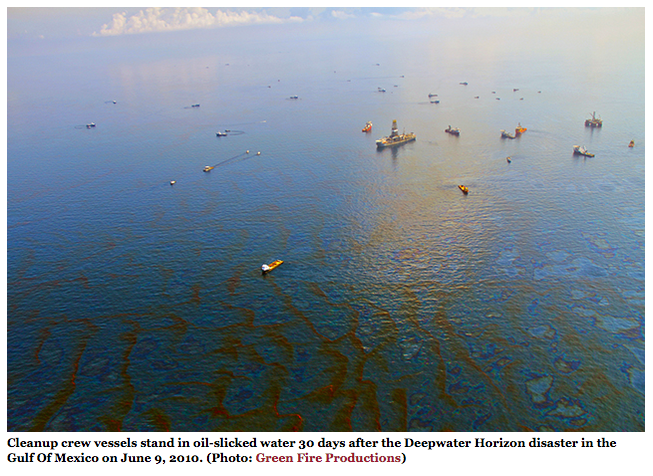The Gulf is still crying, people are dying
From one of our readers, posted two days ago:
I bought and moved into the Gulf going to the hardest hit areas
And today it is still not over. Children and Adults are dying as I write this
BP faces growing scrutiny over latest fatal accident in US
Authorities launch second investigation into Ohio refinery explosion via Financial Times
yesterday

US authorities have opened a second inquiry into an explosion at a BP refinery in Ohio that killed two workers, as the British oil company’s safety record in the US comes under renewed scrutiny.
The Occupational Safety and Health Administration, a federal agency, told the Financial Times it was investigating the incident at the BP-Husky Toledo refinery in Oregon, Ohio, as is required after a fatality.
Fatalities at BP operations have declined over the past decade. Nineteen employees and contractors have died worldwide in the past 10 years, including four killed in a terrorist attack in Algeria in 2013, compared with 128 deaths between 2002 and 2012.
But the FTSE 100 company has a particularly chequered history in the US. In 2005, 15 people were killed and 170 injured in an explosion at a BP refinery in Texas, which the US Chemical Safety and Hazard Investigation Board blamed on “safety deficiencies at all levels of the BP Corporation”.
Five years later an explosion at the company’s Deepwater Horizon platform in the Gulf of Mexico killed 11 workers and injured 17, resulting in the worst oil spill in American history. The disaster ultimately cost the company more than $60bn.
In 2013, partly in response to the fallout from that disaster, BP’s then boss Bob Dudley, a US national, appointed an executive vice-president for safety and operational risk to sit on the executive team and report directly to him as chief executive.
Bernard Looney succeeded Dudley at the top of BP in February 2020 and launched one of the most ambitious corporate overhauls in the sector as he committed to reduce the company’s dependence on fossil fuels and invest in greener forms of energy.
As part of the reset, Looney appointed a new executive team but did not appoint a specific senior leader in charge of safety. Under the current structure, BP’s head of safety does not sit on the executive team and reports to the executive vice-president for production and operations, not the chief executive.
BP is in the process of selling the Toledo refinery, which has been in operation for more than 100 years, to Canadian oil group Cenovus as part of a $300mn deal struck in August. Cenovuscurrently owns 50 per cent of the facility, which processes up to 160,000 barrels a day of crude and supplies fuel to markets across the American Midwest.
Records show OSHA has issued the refinery with a series of “serious” safety violations in recent years, defined as an infraction that could lead to serious injury or death. In one incident in December 2021, refinery workers were exposed to methanol, a flammable and toxic gas, due to faulty equipment. In another, fire suppression equipment had not been quickly repaired. Fines for the infractions have been relatively small, totalling about $50,000 since 2016.
Recommended
The facility last went through a major maintenance operation, typically required every five years, in 2019.
Data from the US Bureau of Labor Statistics show 25 people have been killed in incidents at American oil refineries over the past decade.
The US Chemical Safety and Hazard Investigation Board, which oversees industrial accidents, has also sent a team to Toledo to investigate. In addition to the deaths, the incident led to the release of sulphur dioxide and hydrogen sulphide, two toxic gases, and significant property damage, it said in a preliminary statement on Monday.
BP said it was a conducting “a thorough investigation” and “co-operating with investigations conducted by regulatory agencies.” It added that the refinery had been shut down safely and remained offline.
OSHA told the FT it had up to six months to complete its investigation.
BP Oil Spill Conspiracy 2010
Rare Flesh Eating Bacteria Takes Life Of Woman After Visiting Florida Beach




When Covering Up a Crime Takes Precedence Over Human Health: BP’s Toxic Gulf Coast Legacy
It’s the article we all saw coming. People are dying and the US government is quietly admitting it, now that no one is looking.
From TruthOut, by Dhar Jamail:
In 2015, National Institutes of Health sources estimated that 170,000 Gulf residents would die of spill-related illnesses over the next five years.
The US government is not taking any action to help, nor to prevent this from happening again in the exact same way. Corexit is now known to increase the toxicity of an oil spill by 52%, yet it is still in the “response plan” for the next major disaster.
Continue reading
Dispersants can turn oil spills into toxic mist, research shows
From NOLA.com
Louisiana Environment and Flood Control
 A plane sprays dispersant across an oil slick from the 2010 BP Deepwater Horizon disaster. (NOLA.com | The Times-Picayune archive)
A plane sprays dispersant across an oil slick from the 2010 BP Deepwater Horizon disaster. (NOLA.com | The Times-Picayune archive)
By Tristan Baurick, NOLA.com | The Times-Picayune
The dispersant chemicals used to clean up oil spills have the unintended effect of transforming crude oil into a toxic mist able to travel for miles and penetrate deep into human lungs, new research has found.
A study by Johns Hopkins University in Baltimore indicates that the dispersants used during the 2010 Deepwater Horizon disaster in the Gulf of Mexico and other large spills breaks down oil into particles so small that they can easily take to the air. Just agitate the oil-dispersant mixture with a bit of wind, some waves – even raindrops – and the ultrafine particles go airborne, researchers said.
Continue reading

